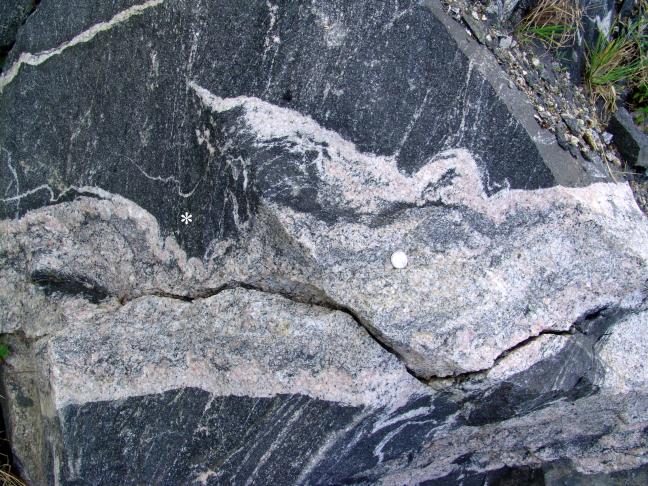Mingling Pegmatitic Granite and Gabbro: Campina Grande, Borborema Province, BrazilRoberto Weinberg, Monash University, Australia Ignez Guimaraes, Universidade Federal de Pernambuco Neysi Almeida, Universidade Federal de Pernambuco |
 Map of South America. White box: central part of the Borborema Province |
CAMPINA GRANDE COMPLEXThis 581 ± 1.4 Ma (U-Pb zircon) high-K calc-alkaline complex (Almeida, 1998) lies within the Borborema Procince, NE Brazil, close to the boundary between the Transversal Domain and the Seridó Belt to the north. The complex is characterized by intense mingling between K-feldspar porphyritic granite and diorite (Almeida, 1999), but here we focus on one quarry where there is evidence for mingling between a pegmatitic phase of the granite and the diorite. The complex is composed of (a) the main, circular body, located between two dextral, N60E-striking shear zones, (b) the tail, emplaced within the eastern shear zone, and (c) the independent Queimadas leucogranite emplaced within an E-W shear zone. The main body is weakly deformed in its interior, but solid-state deformation increases outwards where rocks have recrystallised quartz and myrmekite. External foliation is concordant with the circular shape of the pluton. Internal foliation is relatively shallow (dips smaller than 50o), concordant with the pluton's shape (except in its southern margin), and defines a funnel-shaped pluton in 3D. The foliation close to the southern border is at high angles to the external contact, striking roughly N10W-N10E, parallel to the oliation in the pluton's core. Internal magmatic contacts are independent from pluton shape. The tail, of similar composition to the main body, is strongly deformed including recrystallised amphibole and sub-millimetric mylonitic bands of finely recrystallised felsic minerals. Here, the foliation is predominantly parallel to the shear zone (N60E / 40-20SE).
CLICK ON ANY PHOTO FOR HIGH RESOLUTION VERSION |
MINGLING FEATURES: FIELD AND POLISHED SLABS
Field Relations at Fazenda Brasileiro quarry
Mingled Dykes: Pegmatitic margins mingled with a fine-grained dioritic-gabbroic core. 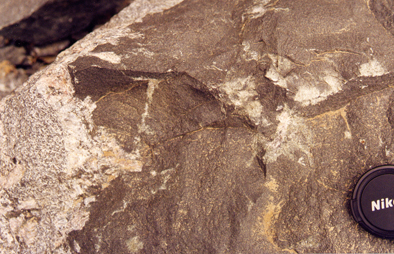
|
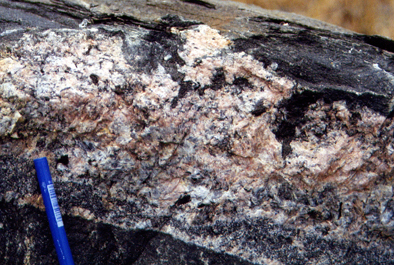
|
Figure 1. A) Granite and pegmatite relations against diorite giving rise to irregular boundaries. Note that the diorite has a number of alteration patches. B) Typical syn-magmatic relationships between pegmatite and diorite along dyke margin.
|
|
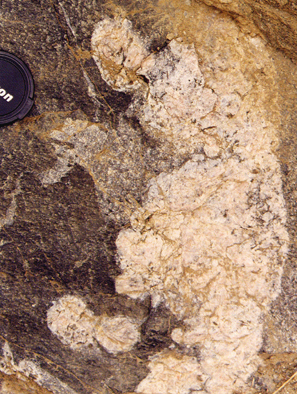
|
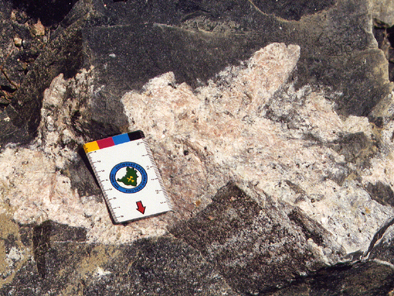
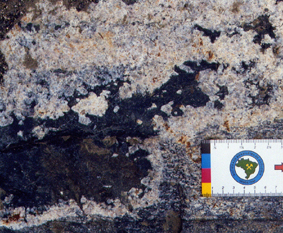
Figure 2. Mingling
relationships in the field between pegmatite and
diorite along dyke margins. A) Dioritic dyke with pegmatitic margins at
Fazenda Deserto quarry. The boundary between the two is irregular and
large
K-feldspar megacrysts grow in from the margins indenting the diorite,
and some rounded megacrysts are surrounded by diorite
(in 2D) possibly partly assimilated. Such relationship between the two
melts are common in the quarry and may be found also in irregular
bodies. B) Detail of A. C) and D) Other examples.
Other uncommon field relationships between
granites-pegmatites-hybrid granitic rocks-gabbros
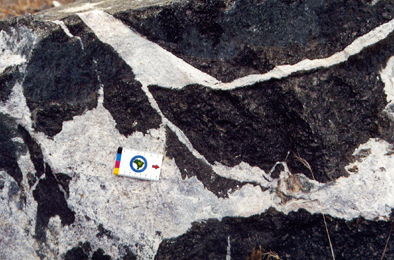
|
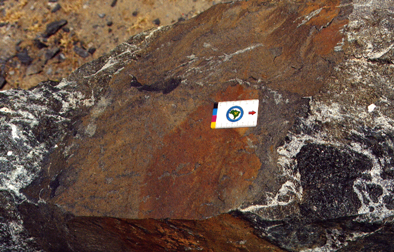
|
Figure 4. Other field relationships between leucogranite and pegmatites with diorites and other hybridized rocks. A) and B) Intrusion of pegmatitic material into coarse diorite with irregular margins tending to lobate. C) Injection breccia of pegmatite into a hybrid mafic rock. D) Fine-grained diorite intruding the breccia in A. Note that the hybridization of the felsic material and its intrusion into the fine diorite dyke.

|
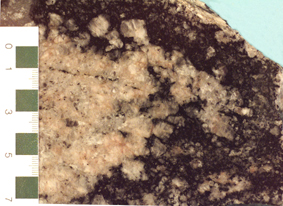
|
Figure 5. A) Typical hybrid granitic rock of the Fazenda Brasileiro quarry. B) section parallel to the banding see Figure 7.
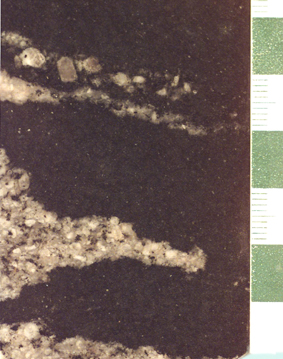
|
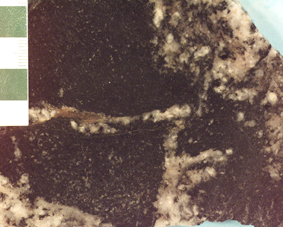
|
Figure 6. Relationship between granites and their pegmatitic fluids and diorite.
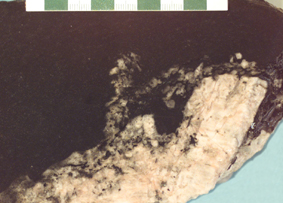
|
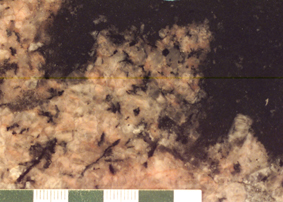
|
Figure 7. Polished slabs showing relationship between pegmatite and diorite.
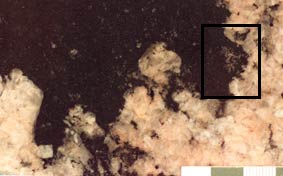
|
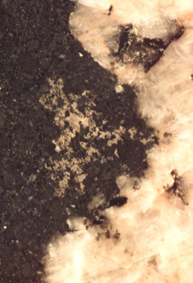
|
Figure 8. A) Contact between pegmatite and diorite. B) Detail of A showing K-feldspar growing dendritically along the interstices of the diorite.
Photomicrographs
Orbicular honeycomb texture in mingled diorite
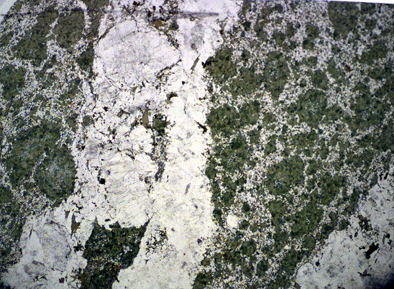 |
 |
Figure 9. Irregular contacts between diorite and pegmatitic granite with the development of orbicules formed by a rim of hornblende and a core of augiteA) sample FD09. B) sample FD13. The orbicules are embedded in a fine matrix characterized by a honeycomb texture (depicted below in figures 12). Field of view: 2.5 cm
 |
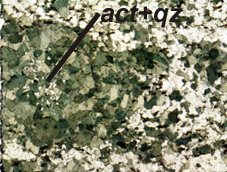 |
Figure 10. Details of the orbicules of sample FD09, hornblende rims surrounding a core of augite and worm-shaped quartz. Figure on the left, field of view 7.0 mm; on the right, field of view 3.5 mm.
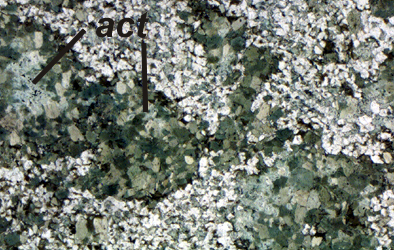 |
 |
Figure 11. Details of the orbicules of sample FD13. Here the cores are comprised of augite and opaques. Figure on the left, field of view 7.5 mm; on the right, field of view 5 mm.4
Honeycomb texturein orbicular diorite matrix. This texture is characterized by the fine growth of interlinking mafic minerals (mostly spider-like biotite and amphibole surrounding small equant plagioclase grains.
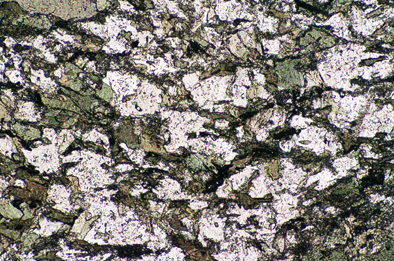 |
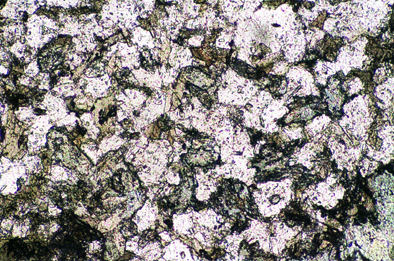 |
Figure 12. Honeycomb texture in dioritic rocks close to contact with pegmatite/granite. This is the material interstitial to the orbicules depicted in Fig 10, 11. A) Sample FD09; B) Sample FD13. Field of view ~ 1.5 mm.
Poikilitic Texture: some diorites develop the orbicular honeycomb texture in contact with pegmatite/granite, others develop coarse poikilitic phenocrystals of biotite or plagioclase as exemplified by sample FD4B in Figs 13 and 14.
Poikilitic biotite in sample FD04B
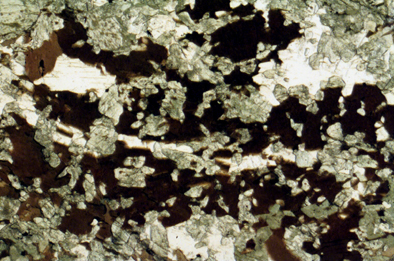 |
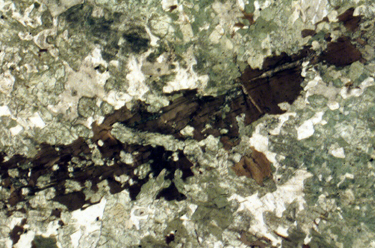 |
Figure 13. Poikilitic biotite grains in coarse diorite in contact with pegmatite. A) General thin section view, B) single poikilitic biotite including grains of hornblende and augite.
Poikilitic, interstitial plagioclase in sample FD04B
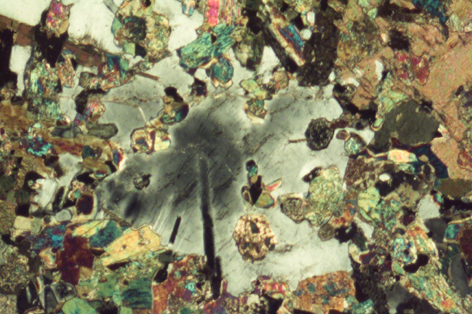 |
 |
Figure 14. Two poikilitic plagioclase grains in diorite (sample FD4b).
